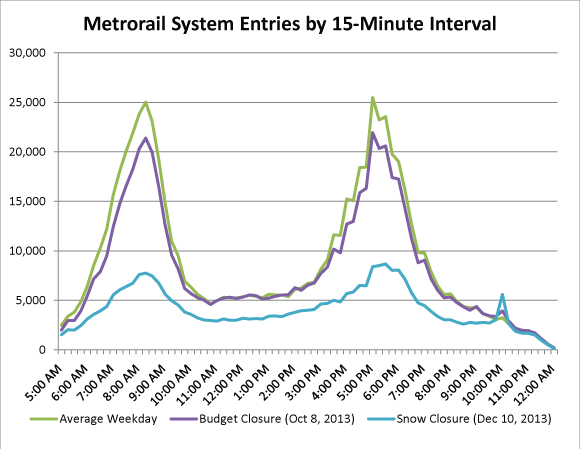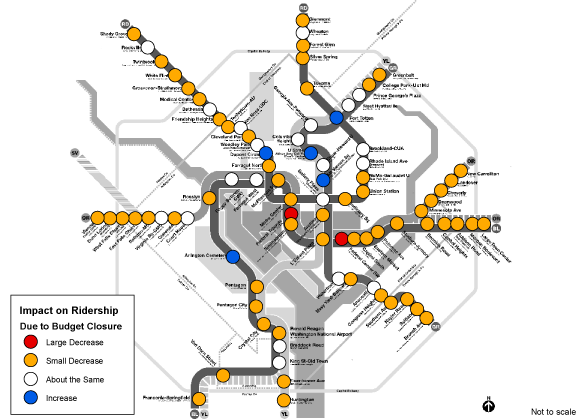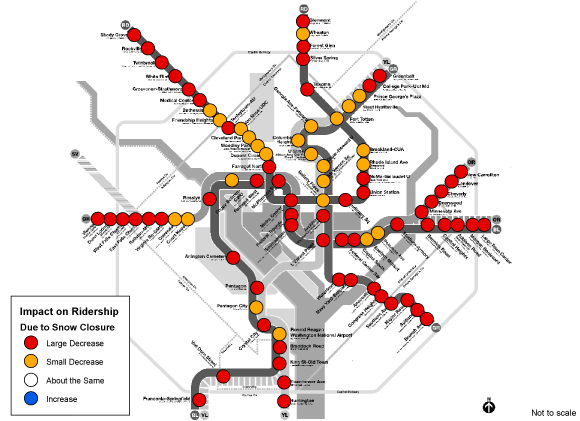The Impact of Government Shutdowns on Metrorail Ridership: Budget vs Snow
When it comes to impacting weekday Metro ridership, meteorologists are three times more powerful than the federal government.
Many factors influence Metrorail ridership, including the weather and the status of the federal government. As this assessment shows, extreme weather has a much bigger impact on Metrorail usage than the federal government closure for budget reasons.
In the past few months, the federal workforce was instructed to stay home for two different reasons. The first was the failed budget negotiation that resulted in the federal government shutdown in October of 2013. (We’ll call this “shutdown closure.”) The second was the winter weather forecast that closed federal offices in the Washington region. (Let’s call this “snow closure.”) These two separate government closures have had different impacts on Metrorail ridership.
First, take ridership by time of day. The graph below shows ridership by fifteen-minute interval for three days. The tallest, green line is the average of weekday entries. The other two are days that the federal government was closed due to the shutdown (Oct 8, 2013) and snow (Dec 10, 2013). Now, the purple line illustrates the ridership due to the budgetary shutdown in October 2013 and the blue line shows ridership on a federal snow day in December 2013. The purple line (budget shutdown) is not dissimilar to the green (average), but the purple line (snow shutdown) illustrates a huge ridership drop. Why would this be?

Metrorail ridership on an average day and two days the federal government was shut down. October 8, 2013 was part of the budget shutdown. December 10 2013 the fed was closed due to snow.
We can think of a few reasons for this difference.
- The budget shutdown only impacted SOME federal workers, i.e. those not deemed essential. Snow, however, impacts just about everyone.
- On snow days, area schools are often closed. Parents who have the luxury to do so sometimes stay home to look after their children who would otherwise be in school. Critically, parents who may be limited in child care options – many of whom are our customers – are especially vulnerable and often are forced to stay home because of the school closures.
- Washington is gradually evolving from a federal “company town” into a “boom town of the new economy,” a new economy less reliant on the federal government. Many of the businesses of the “new economy” were unaffected by the budget shutdown, but during extreme weather events take their cue from the federal government and give their employees the day off. According to Dr. Stephen Fuller of GMU’s Center for Regional Analysis, the Washington region is and will be “increasingly less dependent on federal spending as the driver of job growth and income generation in the local economy.”
Next, let’s look at change in ridership by station. Below are maps showing the change in ridership between a regular day and one of the government shutdown days: first budget shutdown and then snow shutdown.
During the budget shutdown, the two stations impacted the most (ridership slashed to 45% of a normal day) were Federal Triangle and Federal Center SW. Coincidence? Not likely. Instead, these two stations are likely those nearest agencies with the largest number of non-essential employees. The next tier of “small decrease” (ridership at between 50% and 95% of a normal day) spread through out the system are likely origin stations for federal employees which all saw a similar decrease in ridership. Oddly enough, many stations showed unchanged ridership (between 95% and 105% of a normal day) and other stations saw increased ridership (greater than 105% of a normal day). Perhaps federal employees, with their SmarTrip cards already filled for the month, filled their days with other, non-work travel.
The snow shutdown, on the other hand, had a consistent impact across the region, with many stations experiencing large decreases and some stations only small decreases. It looks as if those stations with only a small decrease are located in neighborhoods that are more residential and more walkable than those with the larger decreases. The inclusion of Clarendon, Friendship Heights, Gallery Place, Pentagon City, and Wheaton in the list of stations with smaller decreases might illustrate employees reporting to work at snow-resistant shopping districts, or transit riders spending their snow days shopping there.
Were you impacted by either of these incidents? Did you stay home, trudge into work, or take Metro for a non-work trip?




Very interesting. Another difference is that many other offices in the DC area follow the federal government closure schedule, but obviously won’t follow that in the case of a government shutdown.
Any chance you could post the excel spreadsheet with the data so people could slice and dice in different ways?
I wonder if some people who normally don’t chose to take metro because they couldnt take a bus or drive safely. Although the increases around U st / Chinatown could just indicate more recreational use.
@Alan
Oh nevermind I was looking at the wrong map below.
This is an awesome post. Thanks for sharing the data.
Snow impact by stations clearly shows that the urban metro area is not nearly as impacted by snow as the suburban areas. If DC is becoming “a boom town of the new economy” and this flattens Metrorail ridership peaking, that will be very good for system efficiency.
Interesting to see that the mid-city Green Line is the most shutdown-resilient stretch, followed by the upper NW Red Line. As Steve posits, perhaps this is related to these areas’ relative walkability (an important factor during a snowstorm) or lesser reliance on federal employment.